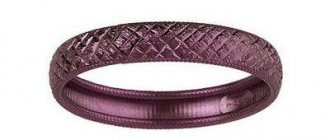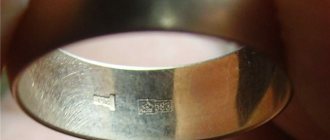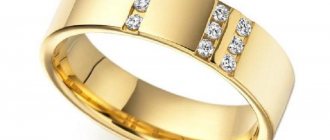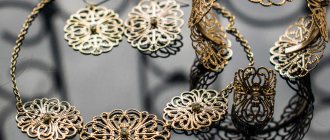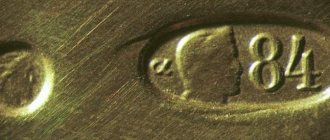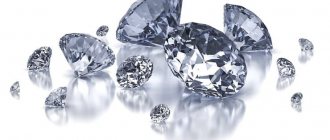Gold is perhaps the only metal that will never lose its popularity. For many centuries, this amazing precious metal has had an irresistible power over man.
Every year, jewelry designers and manufacturers set fashion trends in gold jewelry, including one or another shade of this precious metal. But gold is not just fashion, but, above all, a symbol of beauty and harmony.
Gold is the only metal that, in its pure form, has a bright yellow color. It is a soft, malleable, ductile and malleable metal. One of the most valuable properties of gold is its chemical resistance. That is why gold is the most “noble” of the entire group of precious metals. In addition, the shape and structure of gold molecules are unique: they can be plate-like, round, or needle-shaped.
Due to its beauty and ductility, gold is one of the main materials in jewelry production. Pure gold in jewelry serves as the basis for precious alloys and for gilding. When different metals are added, gold changes color from red to white. This allows jewelers to create products that can highlight the individuality of the owner and the sophistication of the gemstone.
Gold and its alloys
Gold alloys are classified according to color into white, red, yellow, green, pink and others. It is important to know that alloys of the same shade can be of different samples.
The characteristics that an alloy must have are determined by the participation of one or another component in its composition:
- To obtain white gold, platinum, palladium and nickel are added to the alloy. Such compositions have a high melting point and are almost resistant to corrosion.
- Copper and silver make it possible to create an alloy from light yellow to red shades, as well as to achieve greenish and reddish tones. Such products have an average melting point, maintaining the plasticity of the metal and high malleability.
- To obtain an alloy with a low melting point, gold is diluted with zinc and cadmium. Such alloys are often used as solders.
So, the following components can be added to gold:
- Copper. A bright red alloy can be obtained by achieving a copper content of 14.6%. It gives the composition hardness while maintaining its viscous properties. But copper makes the metal more susceptible to corrosion.
- Silver. A white alloy is obtained when it contains 65% argentum. With a silver ratio of 30%, the color will be white-yellow. When adding a small amount of silver, the composition will have a greenish tint.
- Platinum. Used to achieve a white alloy color. A white tint is obtained already at 8.4% platinum content. This metal also increases elasticity.
- Palladium. It is also used to obtain a white tint, but in this case it is necessary to add at least 10% of the substance to the alloy. The metal sharply increases its melting point, leaving its ductility unchanged.
- Nickel. Mainly affects the casting characteristics of the alloy, increasing its fluidity. The color of the composition changes to pale yellow. Nickel is a highly allergenic metal that can cause skin irritation when wearing jewelry for a long time.
- Zinc. Used to impart a slight greenish tint, significantly reducing the melting point. The presence of zinc in the product makes it more fragile.
This is interesting
Interesting information about gold:
- The purity of the metal is determined in carats. The origin of this term comes from the name of the carob seeds. They are used for weighing in the Middle East. The weight of a bean, which is called a carat, is 1.5 g. The weight of gold in carats is 10, 12, 14, 18, 22 or 24. The higher the indicator, the better the quality of the metal.
- Metal is able to conduct heat and electricity well and does not rust.
- The largest gold nugget was found in Australia in 1872. This sample measures 25x63 cm and weighs 70 kg. He was given the name “The Long-awaited Wanderer.”
- Back in the 7th century BC. e. Dentists from Italy began to use gold wire to insert teeth.
- The Aztec word gold meant “experiments of the gods.”
- Window glass is coated with gold because it reflects the sun in summer and retains heat in winter.
- Gold leaf is edible and is used in cooking to decorate desserts.
- About 10 billion tons of the element are concentrated in the oceans, but they have not yet figured out a way to extract it from such depths.
Gold is in high demand all over the world due to its intrinsic beauty, rarity, physical and chemical properties.
Gold samples
There are several established systems for determining metal samples. The most famous of them are metric and carat.
In Russia, the metric system for determining samples has been used for a long time, as it is very convenient and understandable. This system displays how much pure gold is contained in one kilogram of the alloy. For example, if 1000 grams contains 585 grams of gold and 415 grams of impurities (ligatures), the product will be 585 fine.
Each sample has its own characteristics and it is difficult to say which one is better. To store the precious metal in bullion, 999 purity is used, i.e. gold is stored in almost pure form. While the most common standard for creating jewelry is 585.
As for the karate rating system, it is most popular in Europe and the USA. In this case, 24 parts of the alloy act as the base, and the sample shows how many full parts are gold.
So, if a product has a hallmark of 18K, this means that it consists of three-quarters gold and a quarter alloy. In metric parlance, this is 750 sterling. Jewelry is made from the following alloys: 9 carat, 10, 14, 18 and 24.
958 sample
The composition of this sample includes 95.8% pure gold . It is as close as possible to the characteristics of red gold.
The hallmark corresponds to 23 carats in the karat grading system. 958 standard is extremely rarely used by jewelers to create jewelry. This is due to the prohibitively high cost of products and their susceptibility to various types of damage.
The composition of such an alloy, according to GOST 30649-99, in addition to the noble metal, may include the following components:
- Silver – 1.7-2.3%
- Copper – 1.2-2.4%
- Iron – up to 0.08%
- Lead – up to 0.003%
- Antimony – up to 0.003%
The alloy has a bright yellow color with a characteristic shine. It is used only to create some parts of products that are not subject to continuous physical impact.
958 standard is not sold in the form of bars and is sold only as scrap or jewelry. The cost of the alloy is variable and depends on various factors, such as the place of production, the complexity of the work, the place where the product was purchased, etc.
Alloy 958 has not found wide use despite the fact that it is approved by GOST.
750 sample
This hallmark is very popular among jewelers and corresponds to 18 carats. It contains 75% gold, which is the most optimal ratio. How many grams are in 1 carat of gold can be found here.
A fairly high percentage of gold attracts buyers, and it is easy for craftsmen to work with this composition, since it also contains enough ligature (25%). 18k gold is easy to polish and process.
The color of a gold product of this standard varies depending on what constitutes the remaining 25%.
The most common option is white products, for which palladium and silver are used in a ratio of 20% to 5%. The uniqueness of such products lies in their external similarity to natural platinum, however, their cost is 40% cheaper than platinum jewelry.
585 sample
This test can easily be considered the most popular in jewelry making. Rings, cufflinks, chains, bracelets, buttons, family heirlooms, etc. are made from it. 585-karat items do not fade over time and are very durable.
What is added to 585 gold? The shades of gold of this standard can be very different: white, red, pink, green, etc. It depends on the composition of the impurities. The 585 gold alloy classically contains copper and silver.
585 sample has an interesting origin. It appeared after the collapse of the Soviet Union as a replacement for 583 gold, which was not particularly popular. Being isolated from European countries, the USSR itself set standards and tests. By increasing the gold content by 0.2%, the inventors obtained the famous 585 standard, which meets all the requirements of both consumers and jewelers.
500 and 375 sample
500 standard is extremely difficult to find on jewelry counters today due to a number of disadvantages of such an alloy.
Despite the fact that it is approved for making jewelry, almost no one uses it. This is due to the very low casting properties of this sample. It has found its application as a standard for the inspection of jewelry.
375 gold is also rarely found in jewelry stores. Products made from such an alloy quickly lose their attractiveness and shine, which is why the demand for them is extremely low. 375 standard is used in the manufacture of bracelets, cigarette cases, watches, and household items and interior elements are also inlaid with this alloy.
BENDES studio jewelers tell why
In nature, gold is burdened with a number of impurities. Miners need to put in a lot of effort to extract valuable rock from the depths of the earth and rid the mineral of foreign inclusions. The resulting metal is formed into pure gold bars. In Russia, such gold is available for sale at Sberbank, and is called “bank bullion”. To be fair, it is worth noting that even here it is not entirely pure gold. The purity of the bank bullion is listed as 99.99%. This means that the quantitative content of Au (Aurum) per 1000 conventional parts is 999 parts. The remaining one part is the permissible error after cleaning the mined metal.
Yellow gold
Most jewelers prefer to work with yellow gold, which is a unique material. It is quite durable, but at the same time easy to process.
Yellow gold allows you to depict the most elegant and subtle patterns. Pearls, precious and semi-precious stones go well with it.
What is added to yellow gold? Typically, silver and copper . The reasonable cost of these alloys makes yellow gold quite affordable in the price category.
Yellow gold is remarkable because it suits any skin tone. Moreover, it has the same value in all countries and continents. The price of such gold can vary quite widely and depends on many factors described above.
Cleaning yellow gold is quite easy: using hydrogen peroxide, salt and detergents.
White gold
White gold typically contains platinum, silver, palladium and nickel . In terms of price, white gold will always be more expensive than yellow gold, which is associated with the cost of the alloy. You should be especially careful when handling products containing nickel, as this metal causes allergies and skin reactions in many people.
The ideal option is white gold with the addition of palladium and platinum, however, such an alloy can be difficult to find, and the prices for such products are extremely high. Often such jewelry is produced in a single copy or in limited quantities.
White gold jewelry must be plated with rhodium. Otherwise it will have a grayish tint. In addition, this coating protects the gold from microscopic damage.
The disadvantage of white gold is that the coating wears off over time and the product becomes dull. In this case, you need to take it to a jeweler to update the coating. White gold is very delicate and delicate: even chlorine contained in running water can harm it.
Black gold
Black gold is extremely rare and its cost is high compared to other types of gold. It is obtained in several ways: by adding various alloys to the composition, or by spraying ferrous metal powder onto a gold item. Most of the recipes for making such gold are kept secret.
Black gold looks very impressive, rich and elegant. Jewelry made from it is suitable for both men and women. Compared to yellow gold, black gold is more fragile, but, without a doubt, more valuable and expensive.
Product care
To avoid damage to products, you must:
- Remove jewelry before cleaning, washing dishes, or visiting a bathhouse or sauna.
- Store products in a special case or fabric bag.
- At the end of each day, remove jewelry and wipe it with a dry cloth or napkin.
- Protect the product from contact with cosmetics and perfume.
If you need to clean gold from plaque or darkening, you can use home methods, specialized cleaning products, or take the jewelry to a specialized workshop.
Gold is a precious metal used in various fields of activity. Its popularity is explained by its attractive appearance, properties, and technical characteristics. By adding other metals, the characteristics and properties of the alloy can be changed.
Other colors
Modern technologies make it possible to create gold alloys of almost any shade, but not all of them have sufficient characteristics to enter the wide market. So, there are several technologies for inventing purple gold. But such products are not always practical.
In Uralsk, scientists at the Physical Institute of Metals have come up with a way to create green, purple, blue, violet and black gold.
In addition, scientists have discovered the fact that when certain conditions are compared, the surface of gold can acquire different shades. By experimenting with yellow gold, it was possible to achieve a deep blue tint of the alloy.
Methods for obtaining colored gold
There are several ways to obtain colored gold:
- Applying a special coating to the surface of the finished product. It is carried out due to the thermal and chemical reaction of metal alloys with the environment.
- Oxidation. This method involves creating decoration with artificial colors. An oxide layer is applied to the surface of the jewelry.
- Patination. In this case, chemical treatment of the alloy, which contains copper, occurs.
- Oxidation. Gold products are oxidized in air for 30-60 minutes at a temperature of 750-950 degrees Celsius. Thus, cobalt is used to obtain black gold.
- Rhodium plating. Application of rhodium plating on finished products.
- Galvanostegy. This method involves the use of solutions with the addition of special dyes that form a special layer on the jewelry and give it the desired color.
- Gold recoloring is the youngest, recently discovered method of obtaining colored gold. At the atomic level, gold is milled with an ion beam. The structure and depth are selected, light waves are controlled. Thanks to the ability of metals to absorb and reflect waves, any shade of gold can be obtained.
Thus, gold has been valued from time immemorial and is still considered a noble metal. A large selection of alloy compositions makes gold products accessible to people with different income levels.
Physico-chemical characteristics
Aurum is classified as a noble metal (along with silver, platinum and its group metals). They received this name based on their chemical properties: they do not rust, do not oxidize, and do not interact with almost all chemical elements.
| Properties of the atom | |
| Name, symbol, number | Gold / Aurum (Au), 79 |
| Atomic mass (molar mass) | 196.966569(4)[1] a. e.m. (g/mol) |
| Electronic configuration | [Xe] 4f14 5d10 6s1 |
| Atomic radius | 144 pm |
| Chemical properties | |
| Covalent radius | 134 pm |
| Ion radius | (−3e) 185 (+1e) 137 pm |
| Electronegativity | 2.64 (Pauling scale) |
| Electrode potential | Au←Au3+ 1.50 V, Au←Au+ 1.70 V |
| Oxidation states | −1,1,3,5 |
| Ionization energy (first electron) | 889.3 (9.22) kJ/mol (eV) |
| Thermodynamic properties of a simple substance | |
| Density (at normal conditions) | 19.3-19.32[2][3] g/cm³ |
| Melting temperature | 1337.33 K (1064.18 °C, 1947.52 °F)[2] |
| Boiling temperature | 3129 K (2856 °C, 5173 °F)[2] |
| Ud. heat of fusion | 12.68 kJ/mol |
| Ud. heat of vaporization | ~340 kJ/mol |
| Molar heat capacity | 25.39[4] J/(K mol) |
| Molar volume | 10.2 cm³/mol |
| Crystal lattice of a simple substance | |
| Lattice structure | cubic face-centered Cu type, space group Fm3m |
| Lattice parameters | 4.0781 Å |
| c/a ratio | 1 |
| Debye temperature | 170.00 K |
| Other characteristics | |
| Thermal conductivity | (300 K) 318 W/(m K) |
| CAS number | 7440-57-5 |
“Royal vodka”, a composition of high concentration nitric and hydrochloric acids, can dissolve gold.






